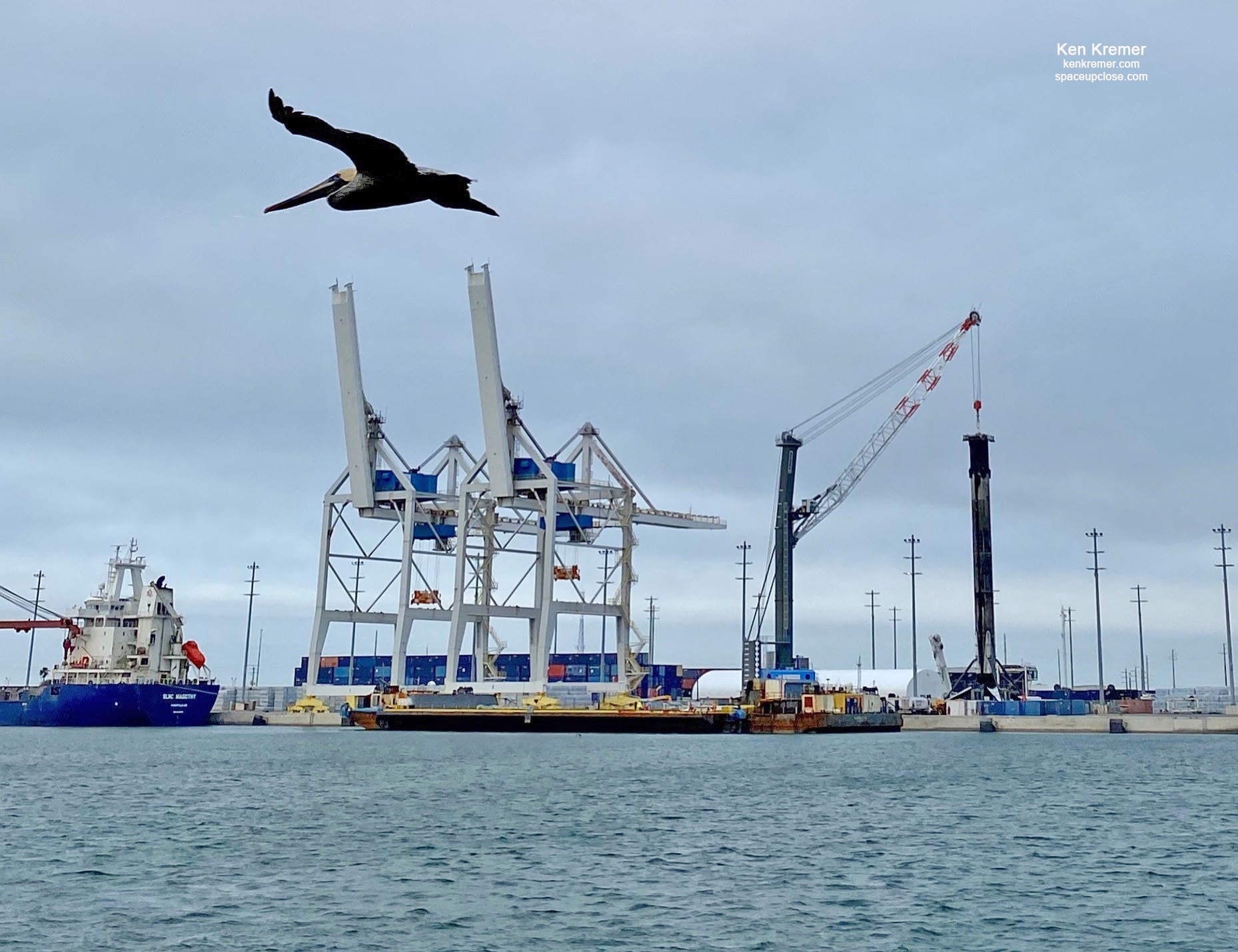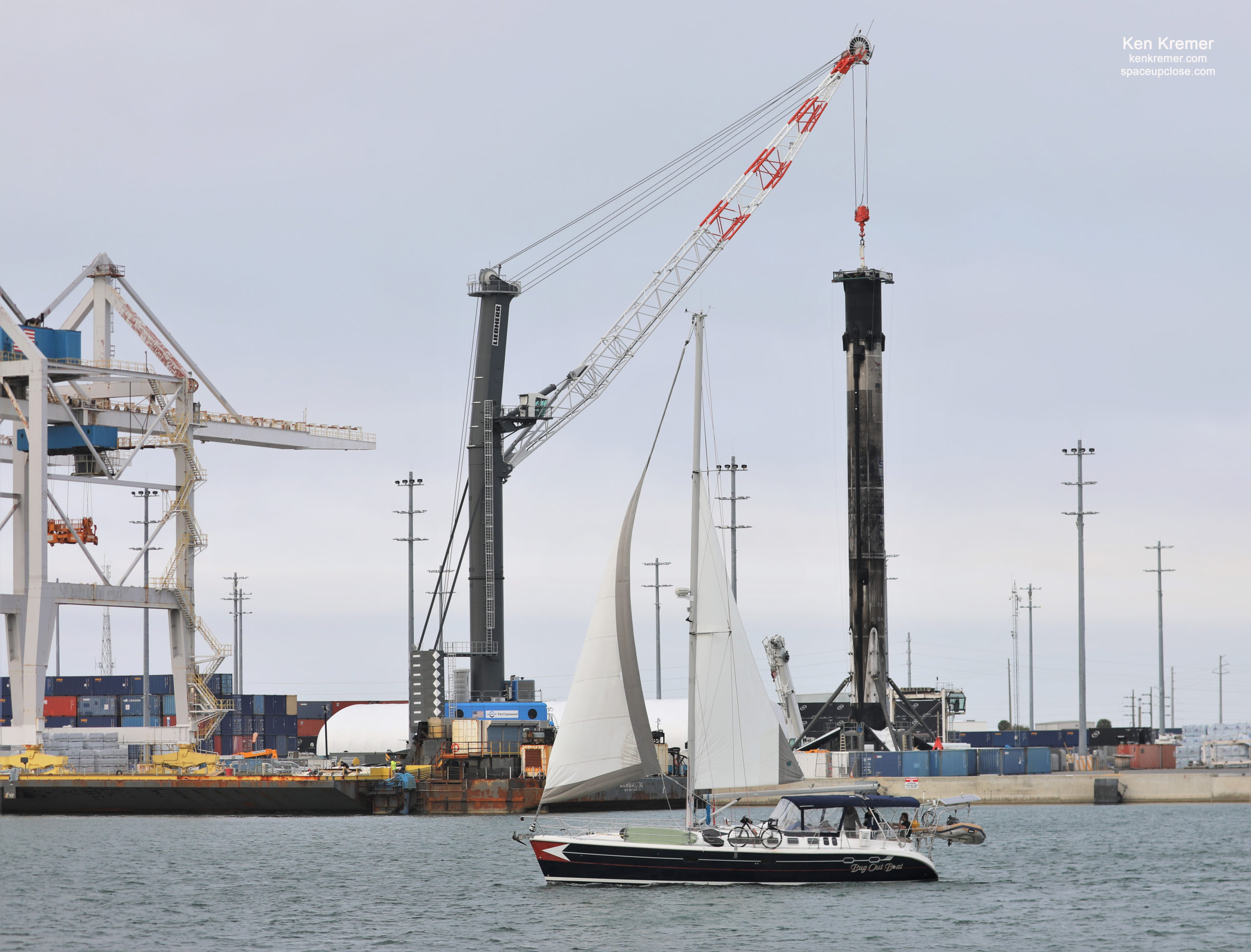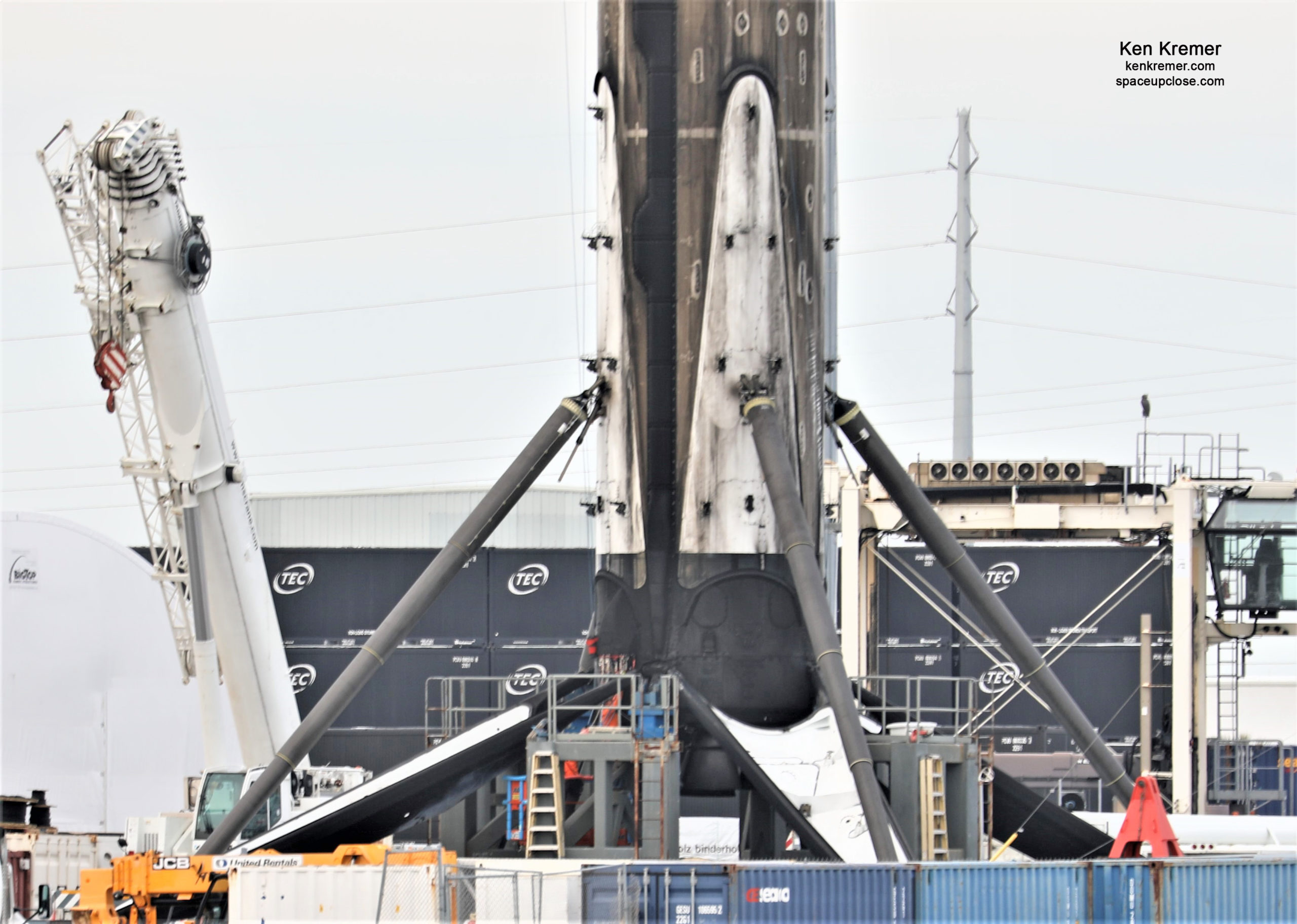
For SpaceUpClose.com & RocketSTEM
PORT CANAVERAL, FL – Amidst threatening sunrise skies the 5x flown and landed SpaceX Falcon 9 booster that launched the latest batch of 60 Starlink broadband internet satellites from Cape Canaveral was towed into Port Canaveral at sunrise Sunday, Feb. 7, atop the sea going OCISLY droneship upon which it soft landed three days prior off shore of the US East Coast in the Atlantic Ocean.
As active thunderstorms, lightning and rain rolled in and out and around the Cape and Port region the SpaceX fleet sailed into Port Canaveral with tug Lauren Foss towing the recycled and sooty 15 story tall booster into the mouth of the ports channel past Jetty Park pier and later berthed at North Cargo Pier 6.
The 156 foot tall booster was firmly grasped and held in place at the base between the four landing legs by the hi-tech octagrabber device as usual.
After a brief weather respite enabling craning off OCISLY I made my way to the Port near sunset Sunday just in time to catch the booster only as gathering gloomy skies and rain returned and rolled back in.
The flight-proven’ booster was welcomed by the Pelican Navy, Sailboats and more!

Enjoy my photos for Space UpClose.
The first stage booster designated as B1060.5 had accomplished its fifth trip to space and back by nailing the soft landing on the sea going droneship ‘Of Course I Still Love You’ (OCISLY) in the Atlantic Ocean – thereby setting up a sixth launch in the not too distant future.

After 5 roundtrips to space and back it appeared to be in rather good shape with roughly the normal expected increased amount of soot on the core exterior.
Liftoff of the flight-proven SpaceX Falcon 9 for launch of 60 Starlink satellites from Space Launch Complex 40 (SLC-40) at Cape Canaveral Space Force Station in Florida took place during the instantaneous launch window at 1:19 a.m. EST, or 619 GMT, Thursday, Feb. 4. 2021.

The magnificent liftoff delighted spectators gathered all around Florida’s Spaceport for the middle-of-the-night moonlit liftoff with rather chilly winter temperatures and low winds that relented at last after many gusty days here.
It successfully streaked to orbit at last just past midnight Feb. 4. on a crystal clear moonlit but rather cool winter night absolutely perfect for optimal viewing!

The Falcon 9 flew past a waning gibbous moon making the nighttime view even more spectacular ! See our photos.
The brilliant display of rocket fire and fury commenced as the 9 Merlin 1D first stage engines roars to life and ignited with 1.7 million pounds of liftoff thrust fueled by liquid oxygen (LOX) and RP-1 propellants.
The rocket flew on a northeasterly trajectory to an initial orbit ranging between 155 miles and 180 miles (250 and 291 km) in altitude – as seen in our streak shot launch imagery.
Enjoy our eyewitness photos of the Falcon 9 launch from the team of Ken Kremer and Jean Wright at Space UpClose.
The mission was to be part of a double header of SpaceX Starlink launches less than a day apart for stunning start to a Space extravaganza double header from Florida’s Spaceport carrying another batch of 60 Starlink broadband internet satellites on a fleet leading recycled Falcon 9.
Alas technical problems with the other booster as well as weather issues forced an indefinite delay to what was to be the 18th mission launched from KSC pad 39A
The 60 Starlink satellites deployed from the upper stage as planned just over an hour after liftoff while flying over New Zealand and the Pacific Ocean.
SpaceX confirmed deployment of the Starlinks with this video tweet from their live webcast:
Deployment of 60 Starlink satellites confirmed pic.twitter.com/96pHRHXZi0
— SpaceX (@SpaceX) February 4, 2021
Following this latest 18th batch this brings the total number of Starlink satellites launched to 1,085 internet satellites. That includes earlier prototypes mostly from the first launch as well as the 10 Starlink sats launched to polar orbit on the last Falcon 9 launch on Transporter-1 mission on Jan. 24. Check out our story and photos
The mission expanding the Starlink constellation to over 1000 also counts as the 107th flight of a Falcon 9 – an amazing launch cadence with nearly a quarter of those just in the past year and in large part enabled by the now routine reuse of ‘flight-proven’ and recovered 1st stage boosters.
It also marked the 74th landing by land or by sea.
Watch this landing video tweeted by SpaceX:
Falcon 9’s first stage has landed on the Of Course I Still Love You droneship pic.twitter.com/4idBRdW65H
— SpaceX (@SpaceX) February 4, 2021
The new mission thus fortifies the Starlink constellation of relay satellites that one day upcoming will offer a competitive alternative to existing broadband services across North America – including the US and Canada
The Falcon 9 first stage rocket booster supporting this mission previously flew on four missions: the launches of GPS III Space Vehicle 03 and and two Starlink missions and most recently the Turksat 5A launch on Jan. 7 that opened the 2021 launch year. Check out our story and photos.
Following stage separation, SpaceX again nailed the landing of the 5x reused Falcon 9 first stage on the “Of Course I Still Love You” droneship, which was prepositioned in the Atlantic Ocean of the coast of the Carolina’s some 400 miles (640 km) northeast of the launch site.
My commentary about the Starlink missions 18 & 19 was featured on WKMG CBS 6 Orlando TV News and Fox 35 Orlando on Feb. 3 & 4:
My static fire test photos for the pad 39A mission were featured on WKMG CBS 6 Orlando TV News multiple broadcasts on Feb. 1 – 3.
Watch Ken’s continuing reports about Artemis and NASA missions, SpaceX, Starlink, Commercial Crew and Starliner and Crew Dragon and onsite for live reporting of upcoming and recent SpaceX and ULA launches including Crew 1 & 2, Demo-2, ISS, X-37B, Solar Orbiter, Mars 2020 Perseverance and Curiosity rovers, NRO spysats and national security missions and more at the Kennedy Space Center and Cape Canaveral Space Force Station.
Stay tuned here for Ken’s continuing Earth and Planetary science and human spaceflight news: www.kenkremer.com –www.spaceupclose.com – twitter @ken_kremer – email: ken at kenkremer.com
Dr. Kremer is a research scientist and journalist based in the KSC area, active in outreach and interviewed regularly on TV and radio about space topics.
………….
Ken’s photos are for sale and he is available for lectures and outreach events
Please consider supporting Ken’s work by donating at Patreon:
https://www.patreon.com/kenkremer
x



